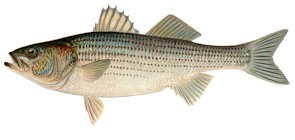It’s “Humuhumunukunukuāpua’a” in case you missed it when the bartender mentioned it in Forgetting Sarah Marshall. As a bonus, I’ll also give you a rundown of all the other states with a state saltwater/game fish. Some you may already know, but some might surprise you! I never would have thought that so many states have striped bass designated as a state fish or state saltwater fish. After all, there are over14,000 species of saltwater fish out there.
(If I missed one please feel free to let me know and I’ll add it to the list. All you have to do is leave a comment of email info@beachchairscientist.com.)
Alabama:
Fighting tarpon (Megalops atlanticus) – These fish can absorb oxygen and live in waters with almost no oxygen.
Alaska:
King salmon (Oncorhynchus tshawytscha) – These fish regularly exceed 45 lbs and the largest on record was a 126 lb caught in 1949.
California:
Garibaldi (Hypsypops rubicundus) – These fish are very territorial and call kelp forests home of choice.
Connecticut:
American shad (Alosa sapidissima) – These fish only have one dorsal fin and one anal fin.
Delaware:
Weakfish (Cynoscion regalis) – These fish are not weak at all but quite strong fighters. The name refers to the easily torn part membrane in its mouth. A fond memory of my childhood involves my grandfather always giving my folks some weakfish he caught on his boat, Irish Eyes.

Florida:
Atlantic sailfish (Istiophorus albicans) – These fish are the fastest fish in the sea and have been observed at speeds above 65 miles per hour.
Hawai’i:
Humuhumunukunukuāpua’a (Rhinecanthus rectangulus) – This fish has blue teeth.
 Maryland:
Maryland:
Striped bass (Morone saxatilis) – These fish are also commonly known as rockfish.

Massachusetts:
Cod (Gadus morhua) – These fish will change colors depending on where it spends its days. If it prefers the sea floor it will appear gray and if it prefers algal areas it will appear greenish.

North Carolina:
Red drum (Sciaenops ocellatus) – These fish got their name from their coloring and from the drumming sound produced by their their swim bladder.
New Hampshire:
Striped bass (Morone saxatilis) – These fish prefer coastlines and are most active in the spring and fall. Sport fishermen love to catch them during the striper runs.

New York:
Striped bass (Morone saxatilis) – These fish are the most popular sportfish on the Atlantic coast.

Rhode Island:
Striped bass (Morone saxatilis) – These fish prefer to eat before dawn and at dusk.

South Carolina:
Striped bass (Morone saxatilis) – These fish do not have eyelids so when the sun is out they prefer to retreat to deeper waters.






















What people are saying …